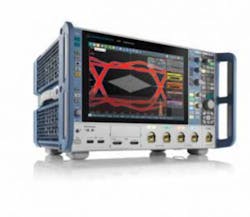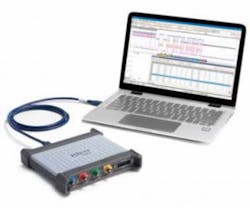Oscilloscopes and VNAs boost time- and frequency-domain analysis options
The launch of new products and options during June has boosted engineers’ choices for both time- and frequency-domain analyses. In the latter category, Anritsu added differential noise-figure measurement capability to its VectorStar vector network analyzer, Keysight Technologies added noise-figure measurement capability to its FieldFox handheld analyzers, and Copper Mountain Technologies debuted a new 100-kHz to 18-GHz USB VNA. For time-domain analysis, Rohde & Schwarz debuted Model RTP 4-, 6-, and 8-GHz oscilloscopes, and Pico Technology introduced FlexRes scopes and MSOs that feature up to 16 bits of vertical resolution and up to 200-MHz bandwidth.
Anritsu’s integration of differential noise-figure measurement capability into its VectorStar vector network analyzers allows R&D engineers to verify the receiver performance of low-noise amplifiers (LNAs) and other devices used in the front-end of 5G and microwave backhaul systems. The option represents the industry’s first solution capable of conducting extensive characterization of the differential noise figure of differential devices used in high-speed wireless communication systems, said Steve Reyes, VNA product manager, while demonstrating the new capability at the International Microwave Symposium in June in Philadelphia. The option is available on VectorStar models operating from 70 kHz up to 20 GHz, 40 GHz, 70 GHz, and 110 GHz.
The new differential noise-figure option enhances the 2-port single-ended noise-figure measurement capability of the VectorStar and allows the VNAs to measure 3- and 4-port devices in single-ended, differential, and common-mode operation with a variety of processing options. The Anritsu differential noise-figure option incorporates the similar cold-source measurement technique as its 2-port method, which minimizes mismatch errors for improved accuracy compared with the conventional Y-factor noise-source method, Reyes said. The enhanced noise-figure option adds the ability to perform levels of vector correction in 2- and multiport devices for greater accuracy, particularly when mismatch is significant.
Keysight Technologies has also been addressing noise-figure measurement, having added the capability to its FieldFox handheld analyzers. Transforming the Keysight FieldFox handheld microwave analyzer into noise-figure mode provides a portable 1-button noise-figure and gain-measurement capability to characterize devices including LNAs, frequency converters, and receivers using the Y-factor technique. An applications engineer demonstrating the FieldFox at IMS said that with engineers’ lab real estate at a premium, it’s beneficial to have noise-figure and other measurement capabilities integrated into a single compact instrument.
“FieldFox provides real-time feedback on measurement integrity with built-in uncertainty bars that can be displayed on the measurement data,” said Dan Dunn, vice president and general manager, Aerospace Defense & Government Solutions. “By combining noise figure measurements with full 2-port vector-network analysis, spectrum analysis, and power-sensor integration, customers now have access to complete characterization of amplifiers and converters in the field or repair depots.”
In other VNA news, Copper Mountain Technologies at IMS announced the release of the new S5180 Compact USB VNA with a frequency range from 100 kHz to 18 GHz. This new vector network analyzer is as portable as the other VNAs in the Compact product series but with an expanded frequency range, the company said. The S5180 Compact network analyzer provides dynamic range up to 135 dB (10 Hz IFBW) and a fast sweep speed. The new product augments the company’s line of metrology-grade USB VNAs that include an RF measurement module and a software application that runs on a Windows PC, laptop, or tablet, connecting to the measurement hardware via USB interface.
As Alex Goloschokin, CMT’s founder and chief revenue officer, has pointed out, “In any analyzer, including the VNA, the location of the processing module (aka computer) is not relevant to its performance. A VNA’s performance is driven by many other factors, but not whether the computer is housed in the same location as the measurement module.”1
Time-domain analysis
With respect to time-domain analysis, Rohde & Schwarz expanded its oscilloscope portfolio with the introduction of the new high-performance R&S RTP family (Figure 1). Faride Akretch, segment marketing manager, reported during a booth tour at IMS that during the development of the new oscilloscope family, the company particularly focused on measurement accuracy, speed, a range of functions, and future-proof technology. The R&S RTP is now available as a 4-GHz, 6-GHz, or 8-GHz model. The company plans more hardware options—such as a generator module with two analog and eight digital channels and a 16-GHz differential pulse source—for 2018, with further R&S RTP models with a higher bandwidth to follow in 2019.
The R&S RTP family combines signal integrity with a high acquisition rate. In standard acquisition mode, it can measure a million waveforms per second, helping users find sporadic errors faster. It also compensates for transmission losses from the signal source to the oscilloscope (de-embedding) in real time. The company reports that the oscilloscope is still fast, even with signal correction activated. And thanks to its digital trigger architecture, it can precisely trigger on compensated signals.
A further feature of the R&S RTP oscilloscope that saves developers time is hardware acceleration for a range of analysis functions. It can perform mask tests at high speed and generate histograms with high statistical reliability. Each RTP model combines multiple instruments, accommodating 16 logic channels, four voltage channels, and four current-measurement channels in addition to the analog oscilloscope channels while supporting serial-bus protocol analysis. Indicative of a trend toward combining time- and frequency-domain analysis capabilities in one instrument, the R&S RTP also offers spectrum- and signal-analysis functions.
Flexible resolution
Finally, Pico Technology’s new PicoScope 5000D Series FlexRes oscilloscopes (Figure 2) and MSOs combine up to 16 bits of vertical resolution and up to 200-MHz bandwidth with a 1-GS/s sampling speed. FlexRes hardware employs multiple high-resolution ADCs at the input channels in different time-interleaved and parallel combinations to optimize either the sampling rate to 1 GS/s at eight bits, the resolution to 16 bits at 62.5 MS/s, or other combinations in between.
PicoScope 5000D MSO models add 16 digital channels, providing the ability to accurately time-correlate analog and digital channels. Digital channels may be grouped and displayed as a bus, with each bus value displayed in binary, hex, decimal, or level (for DAC testing). Triggers can be set across both the analog and digital channels.
PicoScope 5000D Series oscilloscopes have waveform capture memory up to 512 MS to enable the capture of long-duration waveforms at maximum sampling speed. PicoScope’s DeepMeasure tool uses deep memory to analyze every cycle contained in each triggered waveform acquisition, displaying results in a table, with the parameter fields shown in columns and waveform cycles shown in rows.
PicoScope 5000D Series oscilloscopes feature a SuperSpeed USB 3.0 connection, providing fast saving of waveforms while retaining compatibility with older USB standards. The PicoSDK software development kit supports continuous streaming to the host computer at rates up to 125 MS/s.
“The 5000D builds on the success of PicoScope 5000A/B Series flexible resolution oscilloscopes that were introduced back in 2013,” said Trevor Smith, business development manager, test and measurement, in a press release. The 5000D gives designers and test engineers the versatility they need to make measurements on the wide range of waveforms encountered in today’s embedded systems. This allows users to capture and decode fast digital signals and to look for distortion in sensitive analog signals, all using the same oscilloscope.”
Stay tuned for more on IMS
The products describe in this article were launched or highlighted at IMS, which also saw the introduction of RF power devices and ICs, some of which are described on p. 32. Our September issue will include a full report on IMS, describing the instruments, semiconductors, accessories, software, IP, and technologies presented there. In addition, a special report in our October issue will elaborate on spectrum and signal analysis.



